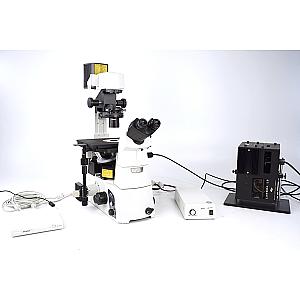The Nikon Eclipse Ti-U inverted research microscope is a high-quality piece of medical equipment designed for medical centers and consulting rooms. Its technologies provide reliability, efficiency, and precision, facilitating the work of specialists and improving the quality of patient care. Configurable with motorized components, it is available in standard and advanced models, enabling high-quality image capture.
Inverted microscope Eclipse Ti-U - Good Condition





Offer Details
Accessories :
Nikon Ti-U Inverted Fluorescence Microscope + Lambda LS + DS-Ri1 / DS-Qi1Mc
Options :
7791
Description
Nikon Eclipse Ti-U Inverted Research Microscope: Precision and Efficiency for Healthcare Professionals
The Nikon Eclipse Ti-U inverted research microscope is an indispensable tool for healthcare professionals, offering exceptional performance and versatility. Designed with the latest technology, this microscope is used daily by physicians around the world to assist thousands of patients. The Eclipse Ti-U model stands out for its reliability, efficiency, and precision, while remaining easy to use.
The Nikon Eclipse Ti-U is configurable with motorized elements, allowing for the automation of various functions and improving observation efficiency. It is available in two models: a standard three-port model and an advanced four-port model, providing increased flexibility for applications requiring high-quality image capture. The standard model allows configuration with a 100% left/100% right eyepiece, and an optional auxiliary port. The advanced model offers an additional lower port, ideal for applications requiring single-photon capture.
The Nikon Eclipse Ti-U's technical specifications include a binocular tube available in several versions (TI-TD, TI-TS, TI-TERG) and CFI eyepieces of varying powers (10x, 12.5x, 15x). The microscope is equipped with 30W or 100W transmitted illumination columns and various condensers suitable for different applications. The motorized six-fold nosepiece and Perfect Focus System (PFS) ensure exceptional image precision and clarity.
The Nikon Eclipse Ti-U is also compatible with a variety of accessories, allowing users to customize their equipment to their specific needs. Available accessories include motorized fluorescence filter cube turrets, motorized excitation and barrier filter wheels, and motorized and mechanical stages.
The Nikon Eclipse Ti-U inverted research microscope is a cutting-edge tool for healthcare professionals, offering a unique combination of performance, flexibility, and ease of use. It is designed to meet the highest standards of medical centers and consulting rooms, while ensuring optimal patient care.
Features
- Reliability and durability for intensive daily use.
- Increased efficiency thanks to the automation of motorized functions.
- Exceptional image precision and clarity with the Perfect Focus System (PFS).
- Flexibility with three- or four-port configurations.
- Compatibility with a variety of accessories for optimal customization.
- Ease of use for comfortable and productive work.
- Recognized and trusted by healthcare professionals worldwide.
Technical Details
- Weight: 42.3 kg
- Dimensions: 50 × 30 × 72 cm
- Ports: Up to 4 ports (100% eyepiece, left/right 100%, AUX, optional)
- Tube: TI-TD Binocular D, TI-TS Binocular S, TI-TERG Ergonomic
- Eyepieces: CFI 10x, 12.5x, 15x
- Diascopic Illumination Column: 30 W TI-DS or 100 W TI-DH
- Condenser: ELWD, LWD, HMC, ELWD-S, high numerical aperture dry and oil, darkfield, CLWD
- Objectives: Sextuple motorized DIC TI-ND6-E, TI-N6, DIC TI-ND6, motorized DIC with PFS TI-ND6-PFS
- Stage: Motorized TI-S-ER with encoders, TI-S-E (110 X transverse travel) x 75 Y mm, dimensions: 400 W x 300 D mm excluding extrusions), TI-SR rectangular mechanical (transverse travel 70 X x 50 Y mm, dimensions: 310 W x 300 D mm), TI-SP blank (dimensions: 260 W x 300 D mm)
- Fluorescence filter cube turret: Six-fold with noise terminator mechanism, motorized option
Compatible Accessories
- Motorized fluorescence filter cube turrets.
- Motorized excitation and barrier filter wheels.
- Motorized and mechanical stages.
- Diascopic illumination columns of various powers.
- Various condensers suitable for different applications.
- Eyepieces of various powers.
- Motorized objective lenses with Perfect Focus System (PFS).